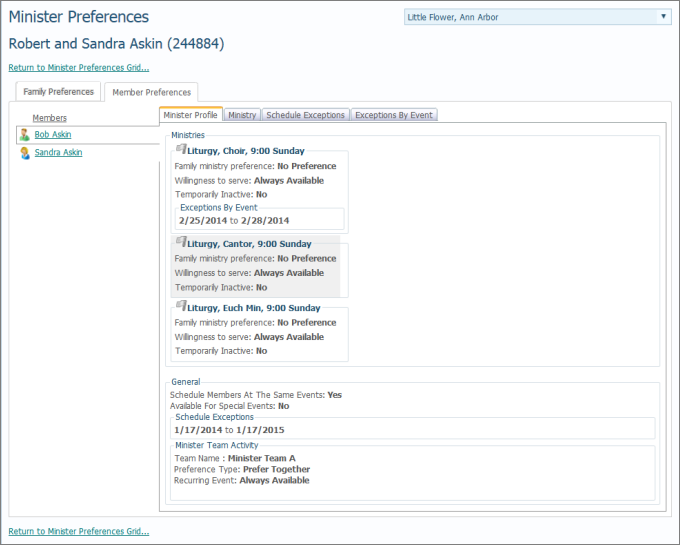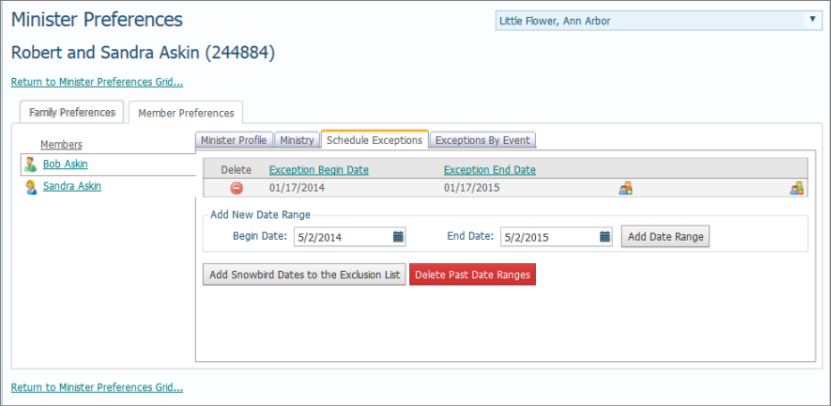Click  .
.
To the left of family’s name. click ![]() .
.
You need to indicate those times when an individual minister and/or a family group is not available to serve. These instructions show you how to view, add, and remove exception dates to a minister's and a family's schedule.
Adding an Exception Date or Date Range for a Member
Adding an Exception Date or Date Range for a Family
Deleting an Exception Date or Date Range for a Member
Deleting an Exception Date or Date Range for a Family
Adding Snowbird Dates to the Schedule Exceptions List
Deleting Past Schedule Exception Dates
Click  .
.
To the left of family’s name. click ![]() .
.
The Member Preferences tab is displayed. For example:

The left side of the Member Preferences tab lists the names of individual family members.
Select the desired family member.
Select the Schedule Exceptions tab to view the selected member's schedule exception dates, as shown below:

Complete the steps under Viewing_Exception_Dates.
In the Add New Date Range section, click ![]() and enter the date range in the Begin Date and End Date fields.
and enter the date range in the Begin Date and End Date fields.
![]() To add a single exception date, enter the same date in the Begin Date and End Date fields.
To add a single exception date, enter the same date in the Begin Date and End Date fields.
![]() For tips on using the calendar
For tips on using the calendar ![]() , see How to Use the Calendar to Set a Date.
, see How to Use the Calendar to Set a Date.
Click  .
.
A message is displayed to inform you that the date range was added.
Click  to clear the message.
to clear the message.
The content refreshes, and the new date range is added to the Schedule Exceptions list.
Complete the steps under Viewing_Exception_Dates.
In the Add New Date Range section , click ![]() and enter the date range in the Begin Date and End Date fields.
and enter the date range in the Begin Date and End Date fields.
![]() To add a single exception date, enter the same date in the Begin Date and End Date fields.
To add a single exception date, enter the same date in the Begin Date and End Date fields.
Click  .
.
A message is displayed to inform you that the date range was added.
Click  to dismiss the message.
to dismiss the message.
The content refreshes, and the new date range is added to the Schedule Exceptions list.
Click this icon to the immediate right of the date: ![]() (the family icon with the plus sign).
(the family icon with the plus sign).
The exception date or date range now applies to the entire family.
Complete the steps under Viewing_Exception_Dates.
To the left of the exception date you want to delete, click ![]() .
.
You are prompted to confirm the deletion.
Click  to delete the exception date.
to delete the exception date.
The exception date or date range is removed from the Schedule Exceptions list.
Complete the steps under Viewing_Exception_Dates.
Click this icon to the far right of the exception date or date range: ![]() (the icon with the minus sign).
(the icon with the minus sign).
A message is displayed to inform you that the date range was deleted for all members.
Click  to clear the message.
to clear the message.
The content refreshes, and the date range is removed from the Schedule Exceptions list.
If a family has specified “snowbird dates” in their Family Directory record, you can retrieve those dates and add them to the Schedule Exceptions list.
Complete the steps under Viewing_Exception_Dates.
To add a snowbird date, click  .
.
A message is displayed to let you know that the dates were added to the list.
Click  to dismiss the message.
to dismiss the message.
The content refreshes, and the snowbird dates are added to the Schedule Exceptions list.
You can delete all exception dates that occurred in the past from Schedule Exceptions list.
Complete the steps under Viewing_Exception_Dates.
Click  .
.
A message is displayed to inform you that all past date ranges were removed.
Click  to dismiss the message.
to dismiss the message.
The content refreshes, and the past exception dates are removed from the Schedule Exceptions list.
<Back to Entering Preferences and Scheduling Exceptions (Administrators only)>